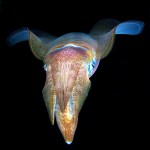sight
Researchers at Stanford University have accomplished what was once considered impossible. They have partially restored vision in blind. Check out this Youtube video to see how they did it
Image from Wikimedia Commons, Author: Alvesgaspar
New research from the University of Lincoln, UK suggests that cats may prefer to find food using their eyes as opposed to their nose. The preference for vision vs. smell was tested in 6 cats placed in a maze that required cats to make decisions about which way to go based on either images or smells. The researchers observed that 4 out of 6 of the cats chose the visual as opposed to the smell cues to obtain their rewards (food). One cat showed a preference for using its nose, whereas one cat showed no clear …
Image from U Penn.
I came across this really interesting press release from the University of Pennsylvania that I just had to share.
Despite having a close relationship with dogs for thousands of years, we are still making new discoveries about our canine friends. Drs. William Beltran (School of Veterinary Medicine), Artur Cideciyan (Perelman School of Medicine), and colleagues teamed up to study canine eyes in an effort to improve treatments for humans with retinal diseases.
Dr. Beltran was quoted as saying “It’s incredible that in 2014 we can still make an anatomical discovery in a…
"According to the special theory of relativity nothing can travel faster than light, so that if light cannot escape, nothing else can either. The result would be a black hole: a region of space-time from which it is not possible to escape to infinity." -Stephen Hawking
You may have encountered objects that are the same size as one another, but have very different masses.
Image credit: Basic Science Supplies / © Accelerate Media.
This is because they're made out of different elements. The higher you go in the periodic table, the larger and more massive your individual atoms are, and so…
Not Exactly Pocket Science is a set of shorter write-ups on new stories with links to more detailed takes by the world's best journalists and bloggers. It is meant to complement the usual fare of detailed pieces that are typical for this blog.
Cold-proof tongue allows early chameleon to catch early insect
Chameleons are some of the most versatile of lizards. They live in baking deserts and freezing mountaintops and part of their success hinges on a weapon that works just as well in the warmth as in the cold - its tongue. Relying on stored elastic power for its ballistic strike, the…
A new study at the University of Wisconsin, Madison, has shed some light (oh... ZING!) on how squids may use another organ, along with their eyes, to see.
Some squids have a light organ on them which they use to camoflauge themselves from predators below them. The organ is filled with a luminous bateria that the squid can activate to light up. The idea is that the squids can illuminate their organs to match the light coming from the surface of the water, thus confusing a rising, hungry fish or giant crab monsters recently loose from attacking deep sea oil drilling stations.
By studying the…


